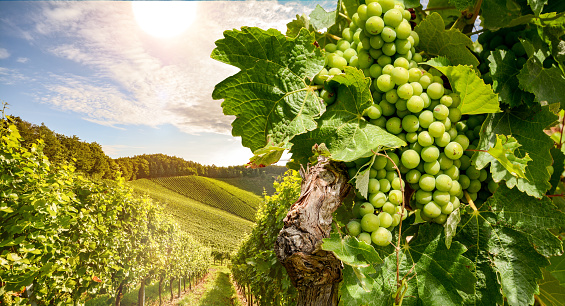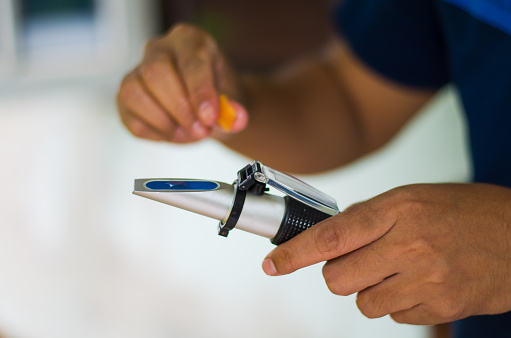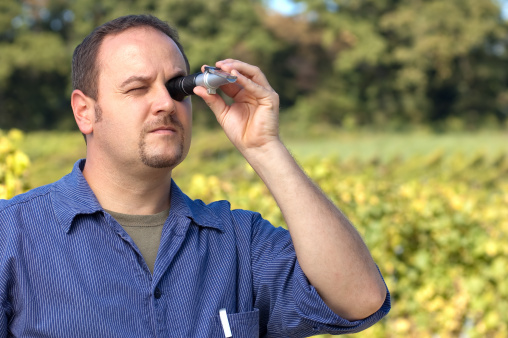
Produce 101: Grapes
Grapes were grown throughout antiquity, with evidence suggesting cultivation as early as 6500 BC. There are three main types of grape uses:
- Grapes for wine
- Grapes for raisins, and
- Table grapes
For Produce 101: Grapes, we are going to focus on table grapes only.

Grape Facts
- The oldest grapevine in America is thought to be a scuppernong vine in North Carolina, estimated at 400 years old
- Grapes are actually berries
- The original Concord grape vine still exists today
Produce 101: Grapes and Grades
There are six USDA grades for table grapes, which are based mainly on external factors:
- U.S. Extra Fancy Table
- U.S. Extra Fancy Export
- U.S. Fancy Table
- U.S. Fancy Export
- U.S. No. 1 Table
- U.S. No. 1 Institutional
California and Arizona, in addition to the physical standards, have Brix requirements.
Produce 101: Grapes and Brix
What is Brix? Brix is the measurement of sugar crystals in the water content in fruit measured with a refractometer. A few drops of juice are applied to the glass and then viewed through the eyepiece to read the measurement.


You can learn more about the technical aspects and how refractometers are used here.
Brix gives us a good baseline on how long that fruit was allowed to ripen and if the grapes are ready to eat. We want to see high Brix which indicates that the grapes were allowed to fully mature on the vine.
You can read more about Understanding Brix in this great article.
Produce 101: Grapes and Varieties
There are also three main colors of table grapes (red, green, and black). Sadly, black table grapes are the least consumed, but may in fact be the best tasting.

California leads the way in terms of domestic production, accounting for 99% of the entire crop. There are currently over 80 varieties being commercially grown, though they are typically not sold by variety name, but rather skin color. Similar to peaches, varieties change throughout their growing season.
The vast majority of the table grapes consumed in the United States are seedless; however, there are seeded varieties, like the Red Globe grape. It is a much larger berry as compared to the others, so if you want an impressive size on your fruit plates, consider using the Red Globe, just be sure to remind people that there are seeds in them.
Grape Storage and Handling
The ideal storage temperature for your cooler is 32 – 38 degrees F.
We recommend you keep your grapes in the coolest part of your cooler. In this illustration, the coolest part is near the fan (1), and the warmest is by the door (3).

Look for grapes that are firm textured and have a sweet flavor, avoiding cracked or shriveled grapes. You want to make sure your grapes are dry in the package; you want to make sure there’s no signs of mold or decay; you also want to look for something called “shatter.”
Shatter
“Shatter” is the term used to describe the grapes that have fallen off the vine in transit or in handling. It doesn’t affect the flavor at all–they’re still delicious, but it does affect the appearance of the bunch. If you’re using grapes as a garnish or in a presentation, if you have bunches with a lot of shatter, shatter will cause empty spots. Some shatter is normal.
Ambering
Certain times of the year you’ll see “ambering” in green grapes, and ambering is just a brownish color. It’s not decay, it’s not old, it’s really an indicator of grapes with a higher sugar content. Typically, it’s towards the end of the season and doesn’t affect anything other than the visual appearance.
Proper Handling of Grapes
Keep your grapes dry, wash them just prior to using, they don’t really want to sit wet they’ll break down a lot faster. Avoid dropping them–that leads to shatter. That also damages, and could even burst, the berries. Don’t stack heavy objects upon them and really order exactly what you need. Don’t keep too many on hand because the shelf life tends to go down the higher the moisture, and the higher the sugar content of the product.
Dan talks about grapes in Produce 101: Grapes
Contact your Sales Consultant about adding grapes to your next order. If you are not a customer, find out how to become one today!
Content provided by Chef Daniel Snowden, the Director of Culinary Development for FreshPoint Central Florida. He has been in the produce industry almost 20 years, and loves getting geeky about food. Follow FreshPoint Central Florida on Facebook, Twitter, and Instagram. Additional contributions by Lisa Brizard.
Some tools you can use:
Visit freshpoint.com for our seasonal availability guides—and while you are there, check out the FreshPress, our latest market report. Place your orders online with ease at myfreshpoint.com. Did you know you can receive real-time reliable delivery alerts on the day of your delivery? Activate and subscribe at FreshPoint.com/mydelivery
Download our app and take your produce management on the go. Place orders, review flyers, watch videos…all in one spot!
Find out more details about our UBU program, and how we are shining a spotlight on food waste while making value and food safety a priority.
We buy local to strengthen regional economies, support family farms, preserve the local landscape, and to provide fresh-from-the-farm food to our customers. Local.freshpoint.com connects you to your local farmers like never before! Customize your search by zip, city, state, radius…even by crops and growing methods. Pop in your zip code and learn about our local farmers.
Socialize with us!
Did you know we are on YouTube? Head over to our page and check out our 75+ videos. Don’t forget to subscribe, and also be a part of our Bell Team—hit the little bell icon to get notifications when we upload new videos.
Follow FreshPoint, Inc. on Facebook, Twitter, Instagram, and LinkedIn…and follow The Produce Hunter on Instagram as she finds the best specialty produce at the Santa Monica Farmers Market.

